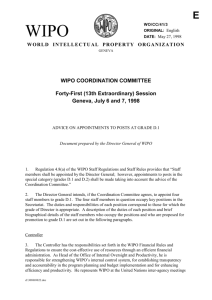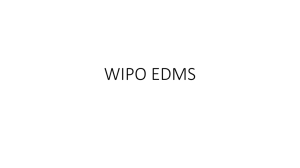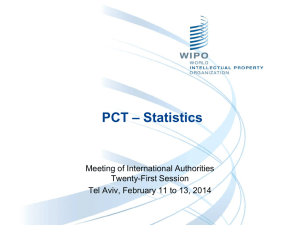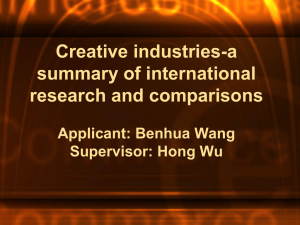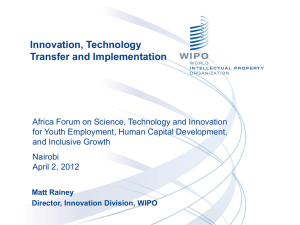A/55/ - WIPO
advertisement
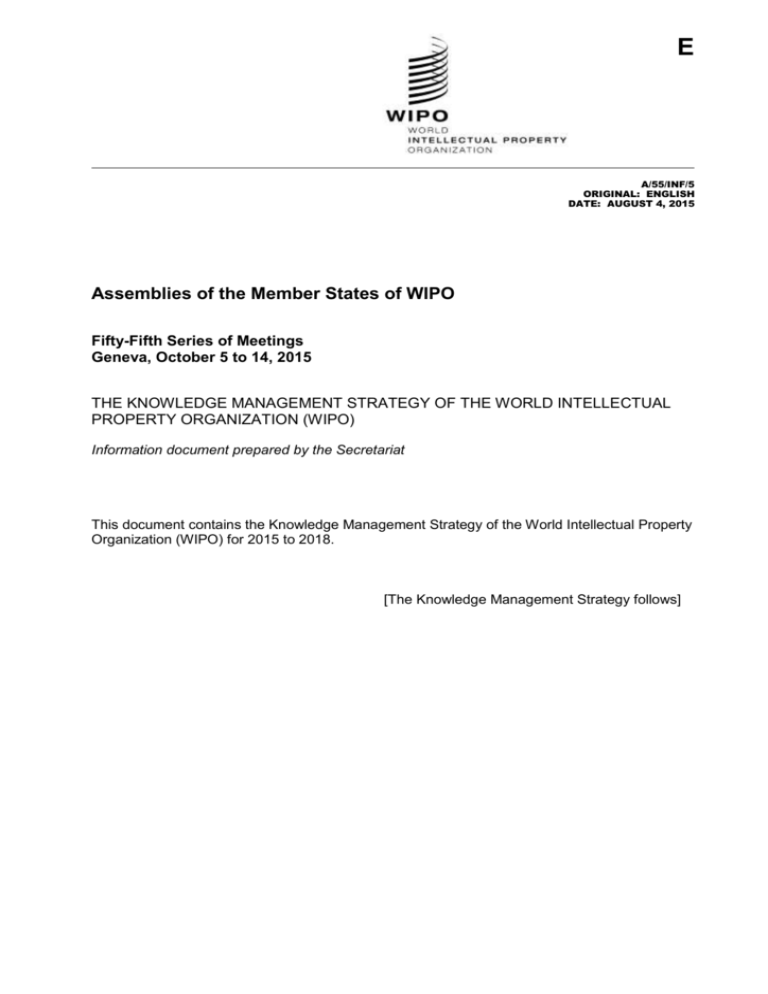
E A/55/INF/5 ORIGINAL: ENGLISH DATE: AUGUST 4, 2015 Assemblies of the Member States of WIPO Fifty-Fifth Series of Meetings Geneva, October 5 to 14, 2015 THE KNOWLEDGE MANAGEMENT STRATEGY OF THE WORLD INTELLECTUAL PROPERTY ORGANIZATION (WIPO) Information document prepared by the Secretariat This document contains the Knowledge Management Strategy of the World Intellectual Property Organization (WIPO) for 2015 to 2018. [The Knowledge Management Strategy follows] Knowledge Management Strategy 2015-2018 Version: 1.0 June 2015 WIPO Knowledge Management Strategy page 2 TABLE OF CONTENTS Executive Summary ..................................................................................................... 3 Scope of Knowledge Management Strategy ................................................................. 4 Description of Knowledge Management ................................................................ 4 Case for change ........................................................................................................... 6 Management capabilities and competencies ....................................................... 6 Managing content retrieval and distribution ......................................................... 6 Culture and Collaboration .................................................................................... 6 Technology tools ................................................................................................. 6 Strategy........................................................................................................................ 7 Strategic Approach.............................................................................................. 7 Knowledge Management Environment ................................................................ 7 Knowledge Management Processes ................................................................... 8 Knowledge Management Strategic Objectives ............................................................10 Strategic Objective 1: Develop a “knowledge management” culture ...................10 Strategic Objective 2: Implementation of an Organization-wide set of knowledge management processes & tools. .....................................................10 Strategic Objective 3: The identification and publication of the “Single Source of Truth” for knowledge and information assets. .....................................................10 Strategic Objective 4: Alignment and integration with Organizational Resilience .........................................................................................................10 Strategy implementation principles .....................................................................10 LIST OF ACRONYMS Acronym Definition IAOD Internal Audit and Oversight Division IP Intellectual Property JIU Joint Inspection Unit MAR Management and Administration Review WIPO World Intellectual Property Organization WIPO Knowledge Management Strategy page 3 EXECUTIVE SUMMARY This Knowledge Management Strategy has been developed in response to recommendations made in the 2014 Joint Inspection Unit’s (JIU) Review of management and administration in the World Intellectual Property Organization1, and builds upon a number of subsequent recommendations made following an internal evaluation of knowledge sharing2, and supports a number of Strategic Goals outlined in the WIPO Medium Term Strategic Plan 2010-20153. The focus for this Strategy is to: Strengthen the existing knowledge management environment within WIPO; and Implement Organization-wide knowledge management processes. Through the implementation of this strategy, the following four Knowledge Management Strategic Objectives will be met: 1 The development of a “knowledge management” culture; The implementation of an Organization-wide set of knowledge management processes and tools; The identification and publication of a “single source of truth” for knowledge and information assets; The alignment and integration between this Knowledge Management Strategy and the Organizational Resilience Strategy. JIU/REP/2014/2: Review of management and administration in the World Intellectual Property Organization (WIPO) WIPO IAOD: Evaluation Report: Knowledge Sharing in WIPO (EVAL 2014-02) 3 WIPO A/48/3: Medium Term Strategic Plan for WIPO, 2010-2015 2 WIPO Knowledge Management Strategy page 4 SCOPE OF KNOWLEDGE MANAGEMENT STRATEGY The 2014 Joint Inspection Unit Management and Administration Review of WIPO4 report includes a recommendation to “finalize a comprehensive knowledge management strategy and present it to the General Assembly by the end of 2015”. It also cites an absence of a structured approach for knowledge management at the corporate level and notes that the absence of a coherent approach “may cause inefficiencies in its day-to-day operations and prevent effective dissemination of lessons learned into substantive and administrative areas”. The implementation of this strategy should “ensure that knowledge created or received by the organization, its institutional memory and lessons learned are systematically captured and disseminated across various sectors”. This Knowledge Management Strategy has been created in part in response to the JIU recommendation, but also to facilitate the coordination of a number of ongoing initiatives which promote and support aspects of knowledge management. Within this strategy, knowledge is defined as facts and information acquired through experience, whilst at a conceptual level Knowledge Management can be summarized as ”ensuring the right people have access to the right knowledge, with the right skills to make well informed decisions”. Fuller definitions of knowledge management within the context of WIPO are provided later in this document. The scope of this Knowledge Management Strategy is: Internally created and managed knowledge which results from WIPO’s operations, including management and administrative functions. Internally created and managed knowledge which results from WIPO’s interactions with external stakeholders, including National IP Offices. Knowledge acquired through interactions with WIPO’s external stakeholders, such as subject matter experts. Knowledge WIPO creates explicitly for sharing with external stakeholders, including via the WIPO Academy. DESCRIPTION OF KNOWLEDGE MANAGEMENT There are many definitions of knowledge management, from academia as well as from industry. Drawing from these definitions, a WIPO specific definition has been derived, which will be central to the scope of the Knowledge Management Strategy: “Knowledge Management is a discipline that promotes an integrated approach for the identification, capture, retrieval, distribution, sharing, use and reuse of WIPO’s information and knowledge assets. Through this discipline, staff, processes and technologies will be aligned to drive the realizable value and benefits of these information and knowledge assets, and contribute to organizational effectiveness, efficiency and innovation.” 4 JIU/REP/2014/2: Review of management and administration in the World Intellectual Property Organization (WIPO) WIPO Knowledge Management Strategy page 5 Within the definition of knowledge management it is also important to draw clear distinctions between data, information and knowledge: Data - facts and statistics collected together for reference or analysis. Information – is data presented within a context which gives it meaning and relevance. Knowledge – results from information in combination with experience and interpretation. There are three distinct categories of knowledge, which each have their own particular challenges for managing: Explicit knowledge - consisting of knowledge formalized, codified and recorded within documents and databases in many different formats, examples would include WIPO Office instructions, mission reports and Treaty texts. Tacit (embodied) knowledge - this is also referred to as intuitive knowledge or “know-how”. This knowledge has been derived from experience, and therefore is difficult to codify into a document and it is embodied within individuals such as WIPO managers and examiners. Embedded knowledge – consists of knowledge within products and processes, including the operational knowledge within the PCT, Madrid and Hague application processing systems. WIPO Knowledge Management Strategy page 6 CASE FOR CHANGE A recent (2014) independent evaluation5 was performed to assess the maturity of knowledge sharing in WIPO in response to the JIU Report. The evaluation focused on the activities, processes and culture in WIPO related solely to knowledge sharing. The key findings of the evaluation have been used as a proxy for wider knowledge management in WIPO and include the topics detailed below. MANAGEMENT CAPABILITIES AND COMPETENCIES WIPO has developed a number of policies, processes and procedures which may not always be interrelated nor specifically targeted towards knowledge sharing. Innovative or multidimensional approaches for the sharing of knowledge are not easily visible across the Organization, in particular for strategy development or the planning of missions. MANAGING CONTENT RETRIEVAL AND DISTRIBUTION A need for greater and more effective information and knowledge sharing across sectors has been identified. There is an absence of coherent organization-wide tools and processes to facilitate content management, the sharing of knowledge and a lack of clarity in the roles and responsibilities associated with internal communication and records keeping in the Organization. CULTURE AND COLLABORATION Whilst collaboration occurs within sectors, greater opportunities could be seized to ensure effective knowledge sharing is practiced across the Organization. Knowledge sharing is not yet a significant or mainstreamed component of WIPO's organizational culture; in addition, more practices, incentives and techniques which would encourage knowledge sharing are needed. TECHNOLOGY TOOLS Several technology applications and tools have been developed and implemented, albeit in a disparate manner, in WIPO in the last few years, including the redesigned Web site, a WIKI, the intranet and the Enterprise Resource Planning tool (ERP), all of which have had a positive impact on information and knowledge sharing. A strategic approach toward digital transformation and better content management is required to provide improved methods for organizing, accessing and using data, information and knowledge in WIPO. The introduction of new tools at WIPO has to continue to support innovation and collaboration rather than create new boundaries. 5 WIPO IAOD - Evaluation Report: Knowledge Sharing in WIPO (EVAL 2014-02) WIPO Knowledge Management Strategy page 7 STRATEGY STRATEGIC APPROACH Through its operations WIPO acquires, creates, processes and stores a significant amount of data and information, some of which is turned into knowledge. As it is recognized that this knowledge is valuable, and a cost has been incurred in the creation of this knowledge, it is therefore critical and imperative to protect and leverage this investment. This Knowledge Management Strategy outlines a framework which WIPO will implement to be able to drive and leverage the organizational benefit of this knowledge. For WIPO to drive the realizable value and benefits from its existing and new knowledge assets, two different sets of capabilities need to be combined: the Knowledge Management Environmental capabilities and the Knowledge Management Process capabilities. The Knowledge Management Environmental capabilities are based upon structures, policies, culture and systems which will enable knowledge management to develop, whilst the Knowledge Management Process capabilities focus on the standardization of the life cycle of knowledge within WIPO. Following the feedback from the JIU Report, as well as the evaluation of WIPO’s existing knowledge management capabilities, WIPO proposes to focus on: the strengthening of WIPO’s existing Knowledge Management Environmental capabilities; and the introduction of Organization-wide Knowledge Management Processes. The implementation of this strategy supports the WIPO Strategic Enabling Goal IX – “An efficient administrative and financial support structure to enable WIPO to deliver its programs”, as well as providing Organization-wide capability which will be used in the delivery of the WIPO Strategic Substantive goals I through VII. KNOWLEDGE MANAGEMENT ENVIRONMENT The Knowledge Management Environment is the supporting environment within which the Knowledge Management processes will be operated. WIPO recognizes the importance of the development of the environment as well as the processes; otherwise the implementation of the processes will become “robotic” and not sustainable. Organizational Structures and Controls for Knowledge Management WIPO will continue to implement the appropriate informal organizational structures to provide coordination across the different business sectors for knowledge management, whilst ensuring that ownership of knowledge assets remains with each sector. WIPO has developed and already implemented a number of policies which indirectly contribute to knowledge management; consequently, building upon previous recommendations6, WIPO will develop a set of policies to support knowledge management, whilst aligning existing policies, as appropriate, in this regard. 6 WIPO IAOD - Evaluation Report: Knowledge Sharing in WIPO (EVAL 2014-02) WIPO Knowledge Management Strategy page 8 Knowledge Management Culture & Behavioral Expectations It is widely recognized that for knowledge management to succeed within an organization and for an organization such as WIPO to become a true “knowledge organization” the activities relating to knowledge management need to become further embedded within the culture of the organization itself. Staff members need to consider how knowledge management can assist them in their role and the impact upon corporate knowledge of every interaction they have with an information or knowledge asset. Therefore WIPO will embark upon the process of enhancing the knowledge management culture within the Organization as a key component of the projects which will be implemented as a result of this strategy. Knowledge Retention and Organizational Resilience The implementation of a Knowledge Management Strategy will take a significant duration of time for an organization the size of WIPO. For this reason it is important to understand the value of different types of knowledge assets to WIPO, the implication of the loss of this knowledge asset, as well as the risk that the knowledge is not retained prior to it being lost or destroyed. Alignment is required between the Knowledge Management Strategy, including its subsequent implementation projects, and the WIPO Organizational Resilience initiative. The Organizational Resilience initiative will assist in the identification and monitoring of the WIPO knowledge assets which are considered enterprise or business critical, which could be lost through unanticipated staff movement, or during an emergency event. The Organizational Resilience initiative will also identify the critical knowledge assets required during the recovery and reconstruction phases following an emergency event. Knowledge Management Systems & Technology In a modern knowledge-based workplace, such as WIPO, the tools for the day-to-day implementation and operation of a knowledge management system are based mainly upon ICT applications. This was recognized within the evaluation report7, so building upon the recommendations made within the same report, WIPO will continue the implementation of technology aimed at enhancing the process for the systematic structuring of, storage and retrieval of knowledge. KNOWLEDGE MANAGEMENT PROCESSES WIPO activities generate knowledge everywhere within the Organization. Until this knowledge is managed via a consistent framework of processes this can be lost and WIPO will be not in the position to reuse internally, transmit or transfer this knowledge to our stakeholders. The introduction of processes to ensure that this knowledge is properly managed will be a key element for the Organization to support the ongoing drive for efficiency. Knowledge Discovery and Detection processes WIPO will introduce knowledge discovery and detection processes to facilitate the identification of existing knowledge sources and to discover any hidden knowledge available in the data and information. 7 WIPO IAOD - Evaluation Report: Knowledge Sharing in WIPO (EVAL 2014-02) – Conclusion 10 WIPO Knowledge Management Strategy page 9 This knowledge resides both inside the Organization and externally, in stakeholders such as National IP offices, partner organizations, academic institutions and other suppliers. Assessment & Organization of Knowledge Assets That knowledge as an asset is not a new idea and for WIPO, as a knowledge organization, to extract value from these knowledge assets they need to be classified, evaluated and categorized. All WIPO staff and external stakeholders are knowledge creators, but it is for WIPO to put in place tools, policies and best practices to ensure that this knowledge is assessed, categorized and organized appropriately. The knowledge assets must be prepared in such a way that they can be identified, retrieved, and understood by the knowledge users. WIPO will therefore implement processes to evaluate and categorize its knowledge assets, including knowledge already held, as well as knowledge being created. Knowledge sharing process WIPO will introduce processes for knowledge sharing, as this plays a determinant role for both knowledge reuse and knowledge creation. Knowledge sharing depends on the habit and willingness of the individual worker to seek out and/or be receptive to these knowledge sources. The right culture and incentives must be present and be assisted through knowledge sharing objectives being set within the WIPO staff appraisal system where appropriate. Knowledge creation & acquisition WIPO will facilitate knowledge creation through the introduction of knowledge creation processes, building upon knowledge sharing, collaboration, and access to relevant data, information and existing knowledge. The ability to create new knowledge, and subsequently manage this knowledge is part of WIPO’s continued drive towards greater organizational efficiency and effectiveness. Knowledge acquisition refers to the knowledge that WIPO obtains from external sources through its operations, sources include external experts, partners, IP Offices, customers and suppliers. The communities of practice can extend well outside the Organization, to the external stakeholders who will contribute to, as well as receive, a number of benefits from WIPO’s Knowledge Management Strategy. Knowledge reuse If WIPO is able to re-use its current knowledge base it will achieve greater efficiency through not having to re-create knowledge with the associated investment in time and budget. Therefore as a result of the Knowledge Management Processes WIPO will implement, including the discovery and organization of knowledge, WIPO will be able to reuse the knowledge it has created and acquired more efficiently. WIPO will therefore introduce processes to drive greater knowledge reuse. WIPO Knowledge Management Strategy page 10 KNOWLEDGE MANAGEMENT STRATEGIC OBJECTIVES WIPO’s Knowledge Management Strategy aspires to build upon existing initiatives whilst being forward-looking, and proposes four strategic objectives which will significantly mature WIPO’s knowledge management capabilities in the areas of people, process and technology, whilst also supporting WIPO’s Strategic Goal IX – efficient administration and financial support structure to enable WIPO to deliver its programs. STRATEGIC OBJECTIVE 1: DEVELOP A “KNOWLEDGE MANAGEMENT” CULTURE This objective ensures that knowledge management is considered an integral part of daily business routines and that WIPO staff understand their responsibilities and appreciate the impact of knowledge management upon their daily activities, as well as the impact their daily activities have upon knowledge management. Ultimately this will result in better governance of knowledge assets, drive clear accountability for knowledge management activities and instill a sense of shared ownership as well as shared benefits from knowledge management. STRATEGIC OBJECTIVE 2: IMPLEMENTATION OF AN ORGANIZATION-WIDE SET OF KNOWLEDGE MANAGEMENT PROCESSES & TOOLS. This objective will ensure that a standardized set of knowledge management processes and tools are implemented within WIPO, which will provide a common set of defined entry points into the knowledge management processes for WIPO Staff. STRATEGIC OBJECTIVE 3: THE IDENTIFICATION AND PUBLICATION OF THE “SINGLE SOURCE OF TRUTH” FOR KNOWLEDGE AND INFORMATION ASSETS. This objective will ensure that for each type of data, information or knowledge asset the definitive source is known and information on this definitive source is communicated to all the relevant stakeholders, therefore allowing for greater re-use of data, information and knowledge assets within WIPO. STRATEGIC OBJECTIVE 4: ALIGNMENT AND INTEGRATION WITH ORGANIZATIONAL RESILIENCE. This objective will ensure that the knowledge assets required by WIPO are identified and managed appropriately, even in times of interruption or change, including as a result of unanticipated staff movement, as well as during an emergency event. STRATEGY IMPLEMENTATION PRINCIPLES Business benefit driven During delivery of this Strategy, each associated project and initiative implemented will need to show direct realizable business benefits to WIPO and/or its external stakeholders, rather than just being a waypoint on the knowledge management roadmap. The benefits of knowledge management is not just for WIPO internally During the delivery of this strategy and the implementation of supporting projects and initiatives, the requirements of the external stakeholders as well as the internal stakeholders and user need to be considered to maximize the benefit of knowledge management. WIPO Knowledge Management Strategy page 11 Knowledge Management is a “Journey not a destination” During the delivery of this strategy and the subsequent strategies relating to knowledge management, it is important that knowledge management is understood as an ongoing incremental activity, with continued environmental and procedural improvements. [End of document]
